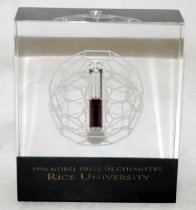Object Record
Images

Metadata
Title |
Paperweight |
Object Name |
Paperweight |
Object ID |
2004.026.002 |
Description |
1996 Rice University Paperweight commemorating Richard Smalley's 1996 Nobel Prize Square plastic paperweight; bottom of paperweight is black with gold lettering; in center is a half full vial with a purple liquid in it (carbon 60?); the image of a buckyball is etched into the back |
Date |
1996 |
Dimensions |
H-4 W-3.5 D-1.25 inches |
Material |
Plastic, Paint |
Collection |
Richard Smalley Collection |
Search Terms |
Buckminsterfullerene Carbon Nobel Prize Winners Nobel Prizes Rice University Smalley, Richard E. |
Provenance |
Discovered in 1985 by the Rice University research team headed by Richard Smalley, Robert Curl Jr., and Sir Harold Kroto, Carbon 60, also known as buckminsterfullerene or a buckyball, is an allotrope of carbon that has a molecular shape similar to a soccer ball or the geodesic domes of futurist architect Richard Buckminster Fuller. Extremely stable and capable of conducting electricity, buckyballs opened up a new area of study in fullerenes, which are being explored for their potential in nanotechnology, electronics, optics, and other material science fields. In the discovery of buckyballs, pulsed laser beams directed at a sample of carbon in the main chamber of the AP2 instrument created a plume of vaporized carbon hotter than the temperature at which some stars are formed. A stream of helium brought about sudden and extreme cooling and the clustering of carbon atoms. A skimmer at the threshold of an adjacent vacuum chamber collected the clusters for analysis by a mass spectrometer. Drs. Smalley, Curl, and Kroto shared the 1996 Nobel Prize in Chemistry for "their discovery of fullerenes." |
